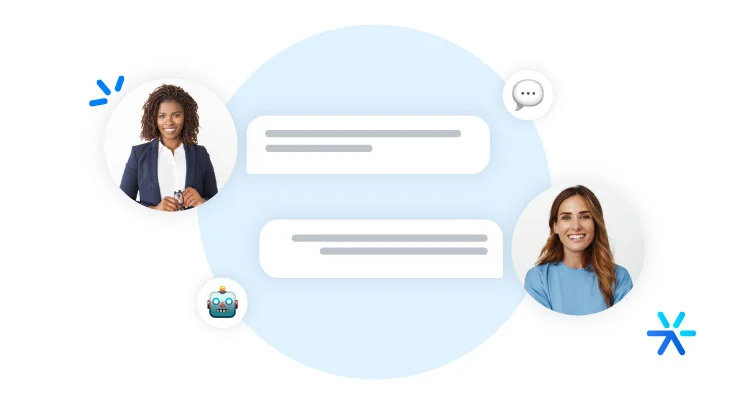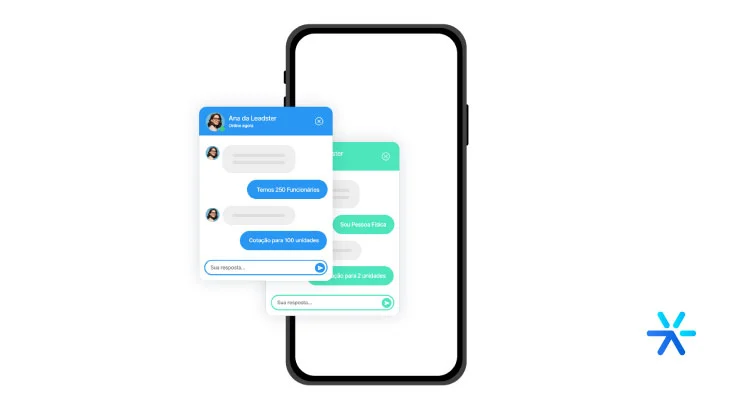Chatbot for Small Businesses: What are the Best Models?
Innovation comes to everyone, including small businesses.
Currently, even small businesses are beginning to invest in customer experience, automation and process optimization, in addition to increasing team productivity.
So a chatbot, an innovation that’s not that new, helps in different areas of your business such as marketing, sales, UX and costumer service.
“But aren’t chatbots used by banks and other large companies that have many customers?” Not really.
You need to streamline your routine and your consumers are expecting increasingly faster and more personalized responses. And chatbots help with exactly that.
Furthermore, we have several chatbot models with excellent cost-benefit on the market. You just have to find the right one for you.
So, let’s start by exploring what a chatbot is and then understand which model is the best for your business.
Ready? 👇
What is a Chatbot?

Chatbots are softwares that simulates human conversations, which can be written or spoken .
Through the tool, users can interact with digital devices in a way similar to communicating in real life .
Chatbots can work with Artificial Intelligence (AI), automated rules – a predetermined scheme of commands and responses –, Natural Language Processing (NLP) or Machine Learning (ML).
And they come in multiple models, each for a specific need your business has. Let’s review them real quick:
What are some types of chatbots?
We can separate chatbots into 4 big groups : chatbot by objective, by type of intelligence, by complexity and by type of configuration.
And, within these groups, there are more divisions, totaling 10 types of chatbot .
Check it out:
Chatbot by objective:
- Costumer Service Chatbot – created to provide information or answer questions about a product, service or process.
- Marketing and Sales Chatbot – generates qualified leads, understanding consumer habits and interests. Collects relevant information for the commercial department and distributes it intelligently.
- Online chat (Live chat) – also known as virtual assistants, they are a mix between costumer service and sales. The main difference is the need for a human team behind it at all times.
Chatbot by type of intelligence:
- Rule-based chatbot – works through a predetermined scheme of commands and responses. Your interaction is through scripts.
- Chatbot based on artificial intelligence – enables the simulation of human intelligence, in addition to having natural language processing (NLP) or Machine Learning technology.
Chatbot by complexity:
- Choice of options chatbots – offers options for the visitor to be guided by pre-defined commands.
- Context chatbots – applied in virtual assistant schemes, such as Siri, Alexa and Google Assistant.
- Keyword recognition chatbots – as the name suggests, they identify pre-programmed words in the system and return specific questions, answers or directions to visitors.
Chatbot by configuration type:
- Code-based chatbots – built from scratch based on code and typically rendered through frameworks.
- DIY Chatbots – created with already robust frameworks, with the customization of rules and criteria following the company’s individual needs.
What are the advantages of using a chatbot for small businesses?

Nowadays, we are always running against time, aren’t we? It’s all very immediate and the demands are urgent, so online users’ attention span is getting smaller and smaller.
That’s where the challenge lies: how to capture the user’s attention and still respond immediately as a small company?
That’s where the chatbot comes into the picture. With it, you can:
- Improves customer interaction;
- Expands response capacity (24 hours, 7 days a week);
- Personalizes the user experience;
- Automates your sales and marketing process;
- Understand your audience better;
- Analyzes your performance in real time;
- Increases your team’s productivity;
- Perform A/B tests to find out which calls give the most results.
What are the possible uses of a chatbot for small businesses?
Okay, now you have in mind what you can achieve by using a chatbot for small businesses.
But what are all the possible uses of this tool?
Let’s find out!
Generate more leads – and, consequently, sales
With the chatbot for small businesses you attract users’ attention in an active and personalized way .
The user no longer needs to wait for a response that could take days or even not happen at all, as is the case with contact forms .
Other than that, you will already have qualified leads in your hands who really know what your company does.
With chatbots, you already mad first contact. You already captured their attention on you website. Now it’s time to offer what you need to convert that visitor into a lead.
It’s like walking down the road. You’ll get somewhere. But the guy riding his bike will get there faster.
Schedule sales meetings
To make your day-to-day life even easier, you can automate meeting scheduling with chatbots.
This way, there will be no more conflicting scheduling, since the lead is the one to choose the best time for the conversation to happen.
Some benefits of this feature:
- Saves time by searching everyone’s schedules automatically;
- Access meeting agendas instantly;
- Hotter leads arrive in less time for your sales team;
- Participants themselves select the best time for a meeting.
Do more with less investment
By implementing a chatbot for your small business, you will gain better results with less investment , as you will have automated and optimized processes that were previously inefficient.
In addition to being able to replace more expensive strategies with the help of a chatbot.
We have a very good example of investment savings when connecting ad campaigns and the chatbot, take a look: How companies are receiving qualified leads without spending more on ads .
Speed up your small team’s time
I told you that time is precious, right?
Well, with a chatbot, your employee will not need to manually qualify the lead or worry about answering everything in a hurry to avoid leaving the customer waiting, as the flow of questions will already be automated by the chatbot.
This was what happened with Contraktor, one of our clients. Without the chatbot, they had the challenge of contacting the lead, scheduling a meeting and giving the necessary attention to the user who entered their website. Now with the chatbot, the scenario is different:
“Sometimes it took us 3, 4 days to speak to a lead after he raised his hand, now it’s faster, on the same day or, at most, the next day”” , commented Rafael Salomão, Sales and Customer Success Manager.
Other uses
In addition to taking advantage of the small business chatbot on your website, you can rely on the tool on other channels, such as:
- Blogs ;
- Whatsapp;
- Facebook Messenger;
- Instagram;
- Capture pages.
Remember, there are different types of chatbots, so you can explore their features ranging from marketing and sales, to customer service and integration with social networks .
What’s the deal with Leadster?

Leadster’s conversational marketing tool is a chatbot for sales and marketing .
It meets the needs of small, medium or large companies looking for this type of solution, increasing lead generation and the conversion rate of its clients’ websites and landing pages by up to 3x.
Some of its diferentials are:
- Active approach;
- Personalization of conversations;
- A/B testing;
- Dashboard with performance metrics;
- Lead qualification;
- Automatic scheduling of meetings;
- Lead Location;
- Lead distribution;
- Integration with more than 200 other solutions, such as RD Station, PipeRun, Pluga, WordPress, Zapier and Exact Sales.
Average rating: 4.9/5
- Rating on B2B Stack: 4.9/5
- Capterra: no reviews
- G2: no reviews
How to create a free chatbot for small businesses?
Have you chosen your chatbot? If you haven’t yet and you’re worried about creation and implementation, check out:
Here with Leadster there are no secrets or complications, in just 3 steps you will have created and implemented a free chatbot on your website!
Check out:
- Start the free trial by acessing our website and clicking on “Get Started Free”. Enter your website details in the chatbot window when it asks for it.
- Set up your account following your objective and segment. Plus, customize your assistant however you wan.
- Finally, finalize your first flow, choosing the pages on which the chatbot will be displayed, what questions will be asked and where the generated leads will go.
It’s that simple!
If you haven’t yet taken the first step and want more reasons to invest in a chatbot for small businesses, take a look at our results page.
You’ll see many small businessess there that took the leap of faith and started using chatbots on their sites. And how that greatly improved their lead generation strategies.
Thanks for your time reading this article. We’ll see each other again in the next one!







